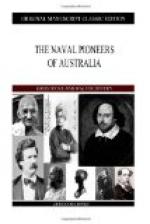In reply to this charge, Murray told King that he could [Sidenote: 1803] “explain” the circumstance; but he soon after returned to England, and these deponents can find no further trace of him.
Soon after it was decided to colonize the new discovery, and the Calcutta, man-of-war, and Ocean, transport, sailed from Portsmouth with prisoners and stores on April 26th, 1803, arriving at Port Phillip on October 10th. Collins, now a brevet-lieutenant-colonel, who was Judge-Advocate under Phillip, was in command of the expedition, and was to be the first governor of the settlement.
King, at Port Jackson, had meanwhile sent—in May, 1803—Lieutenant Bowen in the Lady Nelson, with a transport and a party of settlers, to form a settlement at the head of the Derwent in Van Diemen’s Land.
The expedition was made up of 307 male convicts, 17 of their wives, and 7 children; 4 officers and 47 non-commissioned officers and men of the Marines, with 5 women and 1 child; and a party of 11 men and 1 woman, free settlers. Besides these were about 12 civilian officials. By the close of 1803, Collins, with the concurrence of most, if not all, of his officers, decided to abandon Port Phillip, and convey his colonists to the Derwent settlement. His justification for taking this step was the unsuitableness of the land and the difficulty of procuring fresh water near the heads of Port Phillip. This shows that he was not of the same spirit as Governor Phillip, and that he wrote history far better than he made it.
Bowen had already begun the settlement near what was named Hobart Town by him in honour of the Secretary of State, Lord Hobart. In 1881 the “Town” was dropped, and “Hobart” became the official name of the capital of Tasmania. The man acting as mate of the Lady Nelson was one Jorgenson, the “King of Iceland,” whose remarkable story was written by Mr. Hogan, and published by Ward and Downey in 1891, and whose career was a most extraordinary series of adventures. The Lady Nelson pursued her careful and useful voyages until 1827, when she was seized by Maoris on the coast of New Zealand and destroyed.
In 1817 there came out young Phillip Parker King, son of Governor King, who made four voyages round the Australian coast, completing a minute survey in 1822, when he returned to England and [Sidenote: 1822] published an interesting account of his work. Sir Gordon Bremer in the Tamar, Sterling in the Success, Fitzroy in the Beagle, Hodson in the Rattlesnake, Captain (afterwards Sir George) Grey on the West Australian coast, Blackwood in the Fly, Stokes and Wickham, and scores of other naval officers ought to be mentioned, and no attempt can be made in a work like this to do justice to the merchantmen who, in whalers and sealers or East Indiamen, in a quiet, modest, business-like way of doing the thing, sailed about the coast making discoveries, and often, through the desertion of their seamen, leading to the foundation of settlements.




